Indian food can be so delicious, but there can be unwanted consequences such as gas, bloating, diarrhea, weird poops, and more.
Sorry for the graphic language, but let’s look at the science and research why Indian food can cause trouble with your gut.
As a traveler who’s explored India for +4 years and eaten plenty of Indian food in the USA, I can admit I sometimes get gassy or have other troubles. So I looked at the studies and will answer the questions, does Indian food produce gas, farts, or diarrhea, and if so, how?
Why does Indian food make you so gassy? Indian cuisine has gas-causing ingredients like lentils, naan, and veggies like cabbage and broccoli. Rice also breaks down into carbon dioxide, leading to flatulence. Many dishes have dairy, which is problematic for the 65% who are lactose intolerant. Plus, spices like chilis and turmeric can irritate the digestive system.
If you enjoy eating Indian food, don’t miss any information here so you can eat healthy and comfortably.
In this post, you’ll learn about the Indian foods that cause farts and diarrhea. However, some common Indian spices help reduce gas, which can help.
As I’ve researched how to eat healthy Indian food, I’ve found that many foods could cause gas. Many Indian foods and Ayurvedic remedies can reduce gas, so in this article, let’s look at what might be causing your gas — and how to prevent it during your next meal.
Disclaimer: Gas can be caused for several reasons unrelated to diet, so please see your doctor for more.
This post is a part of my series of avoiding getting sick on Indian food. I also cover delicious Indian dishes, so read the big list of Street Food in India from every region.
5 Reasons Indian Food Might Be Making You Gassy
1. Lentils, Beans, Cruciferous Vegetables, Garlic, Onions, and Mangoes Cause Gas
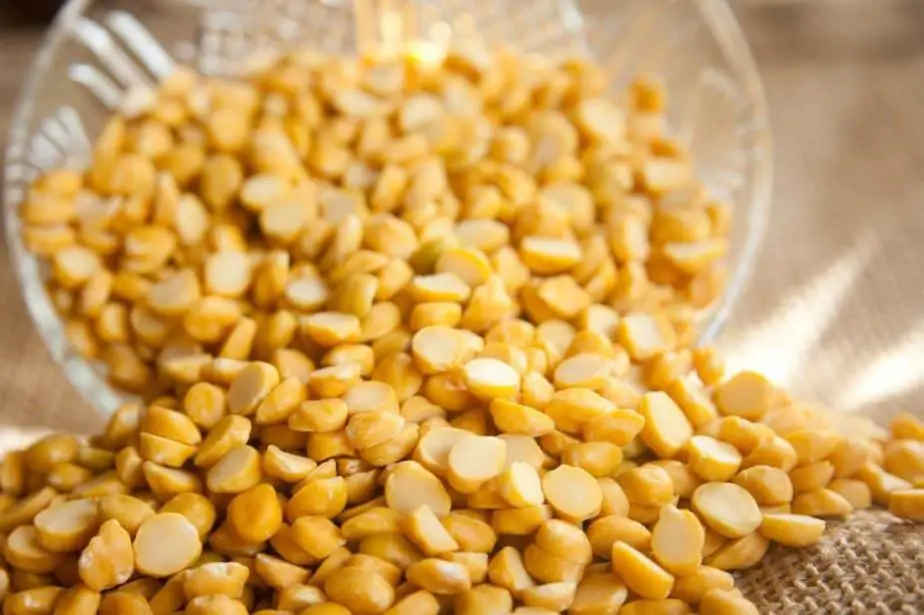
Lentils are a staple in Indian foods. You’ll also find many other beans, breads, cruciferous vegetables like broccoli, and more foods which have a certain substance which causes gas.
Fermentable Olgio-Di-Monosaccharides and Polyols (FODMAPS) are found in many foods like lentils and shown to cause digestive problems like gas. FODMAPs can also cause diarrhea, bloating, constipation, pain, and weird poops.
Indian foods that are high in FODMAPS are:
- Lentils (dal) and beans
- Naan bread, roti and wheat flour
- Cruciferous vegetables like cauliflower
- Beets, mushrooms, peas,
- Spices like garlic
- Onions
- Fruits like mangoes and dates
- Pickled vegetables
- Wheat flour
- Chai, beer, and wine (if drinking more than one)
- Dairy products
FODMAPs are in SO MANY foods, and would be tough to avoid entirely, but if gas is a problem, then avoid foods from this list.
Pro Tip: For an Indian food that doesn’t cause gas try a lassi. This creamy yogurt drink can stabilize some stomachs and help you cool the heat from spices as well — as long as you’re not lactose intolerant.
Read more: Why is Indian Food so expensive in the USA?
2. Eating Starchy Foods Like Rice Must Be Broken Down Into Carbon Dioxide
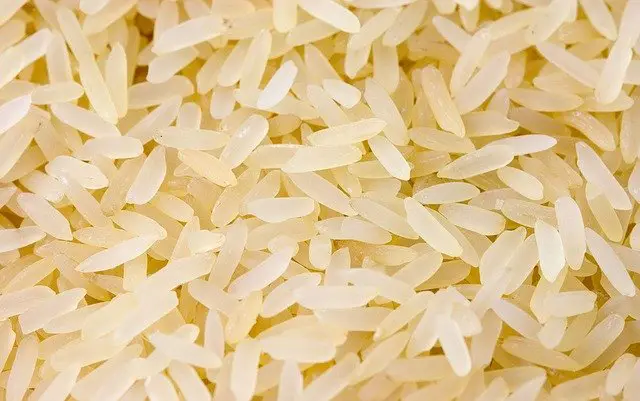
Rice, potatoes, and pasta are all starchy foods that can cause gas. In a typical Indian dinner, it is common to eat rice, and while delicious, after eating, the starch must be broken down to glucose. This is then broken down into alcohol and carbon dioxide, leading to flatulence.
You’ll have more gas if the rice has been reheated.
Think of the rice in a buffet. Even a nice buffet at a 5-star hotel might be sitting for a while and then reheated. This changes the molecular structure of the food and makes it more difficult to break down in our intestines, causing more gas.
Pro Tip: Fresh white rice won’t cause gas in everyone so you could try this with a dish called Kitchari. This mung bean and lentil dish can soothe the stomachs of many people.
Read more: What is Real Indian Food? Here is a long list of authentic Indian dishes
3. Vegetable Oils Are Terrible for You and Your Digestion
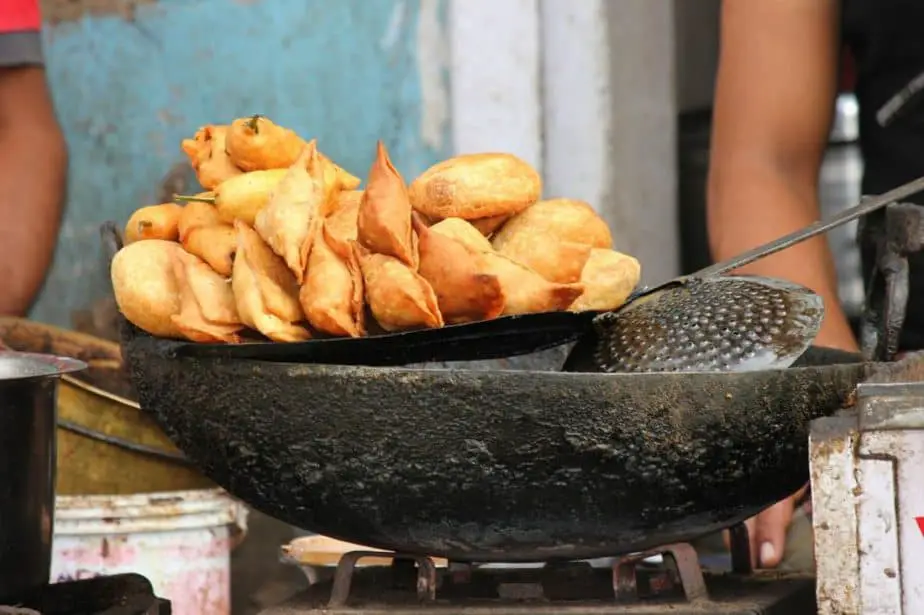
Cheap vegetable oils are commonly used at restaurants and even in households in India. Many people think they are healthy. They are also cheaper than olive or coconut oil, which is better for you.
Processed vegetable oils have a toxin called Acrolein in such high doses, that you would need to smoke a pack of cigarettes to get as much as a serving of potato chips will give you.
Just think what this toxin might be doing to your stomach?
India actually has some locally grown oils that can be very healthy. Coconut, mustard, and sesame oil can all be healthy. Ghee can also be healthy in small quantities.
Recently many international companies have imported and marketed processed vegetable oils in India, making it likely that Indian restaurants are using these oils.
The oils to avoid are:
- Canola
- Peanut
- Soybean
- Corn
- Safflower
- Sunflower
- Rapeseed
- Cottonseed
Ask your restaurant what type of oil is used. The more expensive or organic-style restaurants are more likely to use healthy oils.
If you cook at home, try to use mustard, coconut, sesame, or olive oil from a trusted brand.
Read more: Do Indian Restaurants Sprinkle Cow Urine On Your Food?
4. You Are Lactose Intolerant and Don’t Realize It
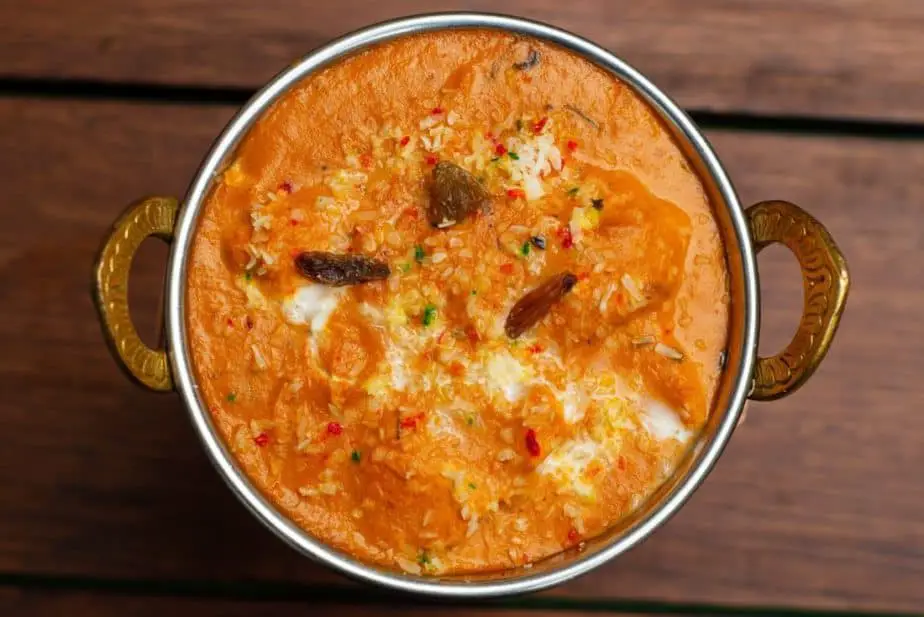
65% of people are lactose intolerant, but they may not realize it, according to the U.S. National Library of Medicine. If your body can’t process lactose (the sugars in dairy), then it will lead to gas, bloating, and diarrhea.
India is the world’s largest producer of milk, and many treat cows as sacred animals. Of course, this means there are many dairy products found in Indian dishes:
- Yogurt is used to cook naan bread
- Cream is in Tikka Masala, Butter Chicken, and other curries
- Ghee (clarified butter) is used as a cooking oil in many dishes
- Curd (yogurt) and buttermilk are often served with thalis
- Tea and coffee always come with milk
- Paneer (cheese) in dishes like paneer butter masala and palak paneer
If you want to avoid milk, then try some of these dishes:
- Desserts made with jaggery (similar to brown sugar)
- Roti or chapati
- Chana Masala – a spicy chickpea dish
- Bhindi Masala – a stir-fried okra dish
If dairy is a problem for you or you are vegan, I wrote a post with 30 dairy-less dishes for those eating vegan in India.
5. Flatbreads Made With Whole Grains
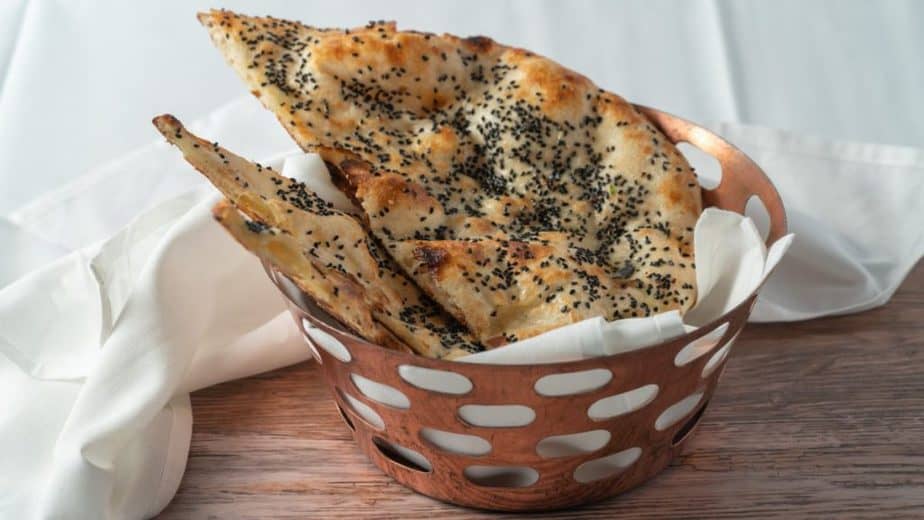
Whole wheat flour is used to make many flatbreads served at Indian restaurants like roti and chapati. These breads not only have FODMAPs but also have fiber.
Fiber can be difficult for the small intestines to break down. Therefore, the food passes into the large intestines where the microbes produce gases like methane, hydrogen, and carbon dioxide.
Fiber can be very healthy though, so this would be one you may want to keep in your diet.
Read more: Why Do Indians Use So Much Curry?
Try These 5 Indian Foods And Drinks To Reduce Gas
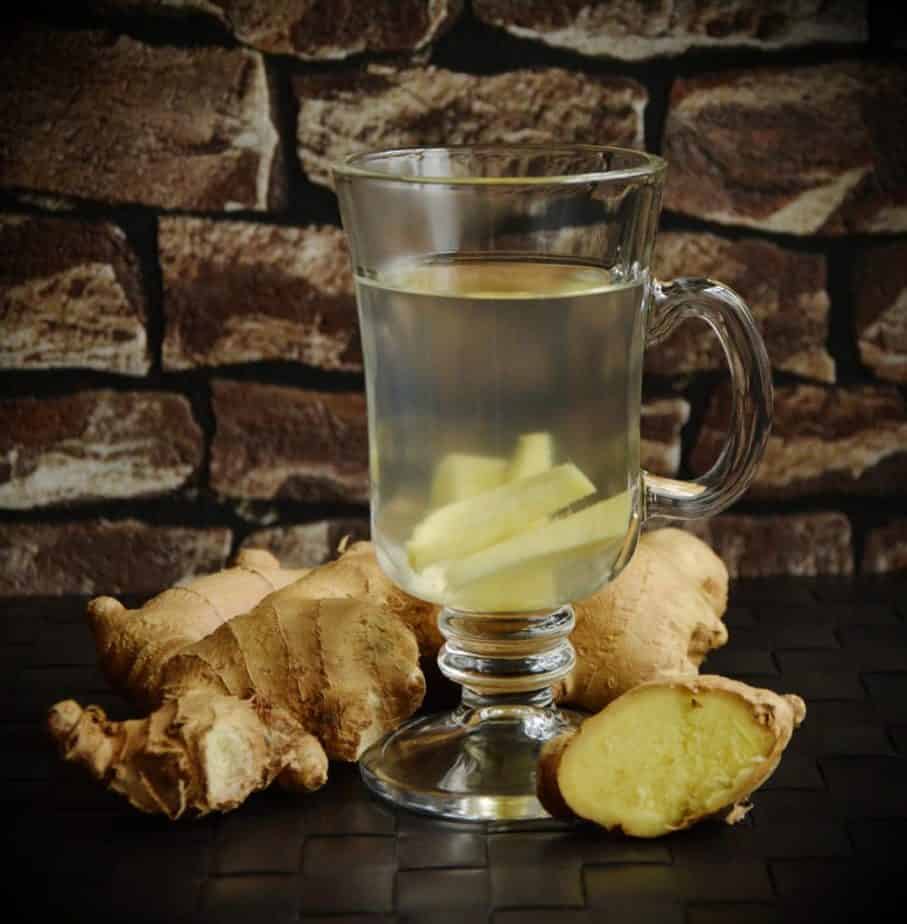
There are many spices in Indian foods; some can reduce the gas in your stomach. India is also the birthplace of Ayurveda, an ancient way of healthy living and eating, which has several remedies for a bloated stomach or gas.
If you are feeling gassy, try these 5 foods or drinks.
1. Drink Ginger Tea

You can drink ginger tea, juice, or some warm ginger water.
Ginger does several things, like help move food through our intestines and helps protect or heal our stomach.
Many Indian restaurants serve ginger, lemon, and honey tea, a great after-dinner drink to reduce gas.
Read more: Why Do Indians Drink Milk, But Not Eat Beef?
2. Eat Cumin Seeds

Cumin is one of the primary ingredients in curry powder and many Indian dishes.
According to a study done by the Oxford Academy, Cumin seeds are also used in traditional medicine and can remedy a number of diseases, including reducing gas.
Cumin seeds help the liver secrete more bile, which helps digestion.
3. Eat Coriander Seeds
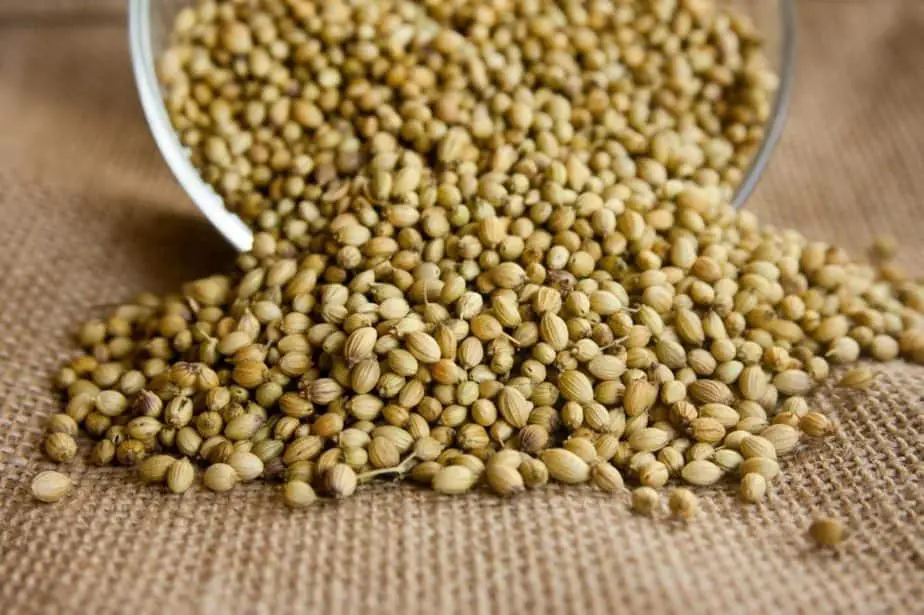
Coriander is another primary ingredient in curry powder and Indian dishes. The seeds as well as the leaves are also used in traditional medicine.
Coriander can help accelerate the digestive process.
Dr. Bharat B Aggarwal wrote a book, Healing Spices, which states that coriander is effective to treat constipation which can accompany gas.
You can take coriander by:
- Buying coriander seeds.
- Crushing just less than a tablespoon of coriander seeds.
- Adding the seeds to a liter of water.
- Letting them soak for 8 hours or throughout the night.
- Straining the seeds and drinking.
4. Eat Carom Seeds
Carom seeds or Ajwain are found in most Indian households and in many dishes. They are often added to the dish dal tadka. They have a strong pungent flavor and are also used in pickles and curry.
Yet carom seeds are also good for the health in many ways, one being that they can reduce stomach pain and gas.
5. Eat Fennel Seeds Or Drink With Warm Water
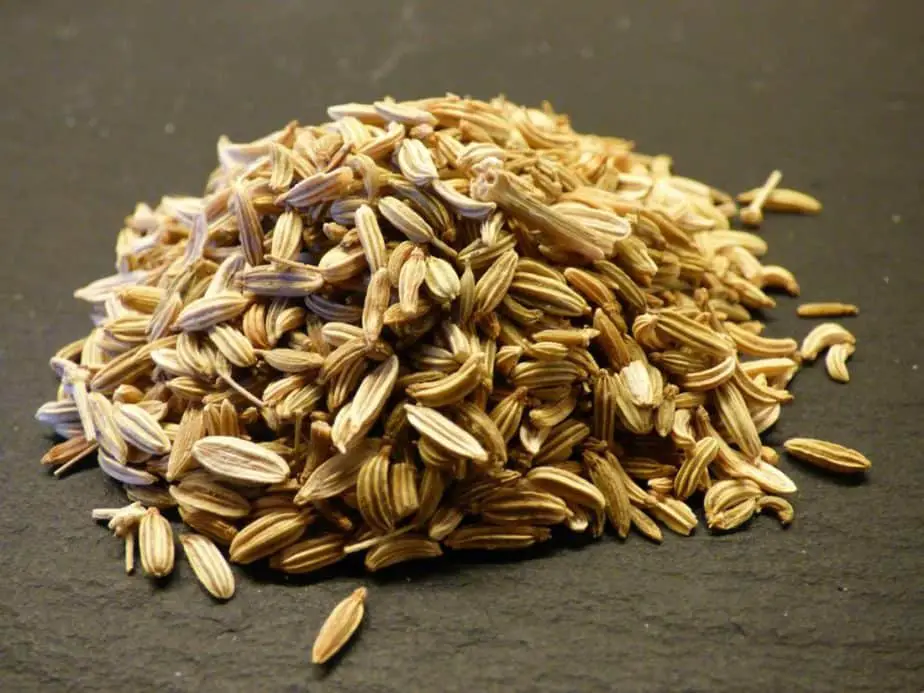
A mixture of fennel seeds are often served at Indian restaurants after a meal as a way to settle your stomach and freshen your breath.
Many Indian people chew the seeds to help aid indigestion. They help by relaxing the muscles in the intestines, helping your meal digest quickly.
Anethole is the key ingredient found in fennel seeds, and it is a derivative of phenylpropene which is often in essential oils.
Dr. K.C. Lineesha of Greens Ayurveda in Kerala, India, recommends drinking a glass of warm water with fennel seeds.
For a more potent mixture, try this after your next meal:
- Toasting 1 teaspoon of fennel seeds
- Mixing with 1 cup of boiling water
- Adding a few small pieces of ginger, a pinch of asafetida (thing), and a sprinkle of rock salt.
- Then sip slowly
FAQ
Why does Indian food give me diarrhea?
Spicy Indian foods contain capsaicin, an ingredient in chili peppers that causes the characteristic burn. Capsaicin can irritate the stomach lining or intestines, leading to discomfort. While the body’s reaction to spicy foods like these is a natural protective response, individuals with sensitive guts may experience diarrhea. The body’s digestion process is complex, and introducing spicy ingredients can sometimes disrupt it for those not accustomed.
Why does curry make you fart?
Curry dishes, rich in fructans from garlic, ginger, and onions, can lead to gas due to their high FODMAP content. Additionally, spicy curries can stimulate the release of stomach acid, which, when fermented in the digestive system, causes bloating and increased flatulence.
Why does Indian food make you poop?
Indian cuisine, abundant in fiber-rich lentils and vegetables, aids in regular bowel movements. Additionally, certain spices in the dishes can stimulate the digestive system, while chili’s capsaicin irritates the intestinal lining, often leading to loose bowels.
Why does Indian food hurt my stomach?
Some individuals might find the spices and herbs in Indian dishes, such as chilis and turmeric, to be irritating. Also, dairy-based sauces can distress those who are lactose intolerant. The oils in Indian restaurant food could be low quality and hurt your stomach. Eating from restaurants and street food stalls with poor hygiene could cause stomach sickness called “Delhi Belly.”
For more, I wrote another post answering the questions, What is real Indian food? In the article, I included 31 authentic Indian dishes you should definitely try.
Final Words
The question of why Indian food makes you so gassy has been on my mind at times and also my readers.
To recap, certain staple ingredients like lentils, beans, and vegetables are rich in fiber and FODMAPs, which can lead to gas production.
Furthermore, dishes laden with spices, especially chilies containing capsaicin, can irritate the digestive system.
Add to that, many Indian recipes have creamy sauces and considering a large percentage of the population is lactose intolerant, it’s not surprising some experience digestive distress.
While the occasional bloating or gas might be a small price to pay for indulging in these delectable dishes, being aware of what triggers these reactions in your body can make eating Indian foods without gas, bloating, or diarrhea possible.

